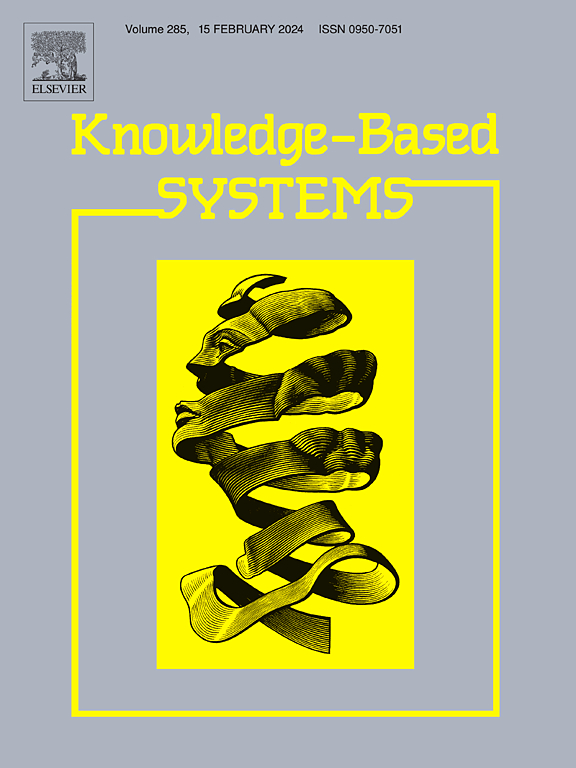一种新的多尺度自适应图对抗网络用于机械故障诊断
IF 7.2
1区 计算机科学
Q1 COMPUTER SCIENCE, ARTIFICIAL INTELLIGENCE
引用次数: 0
摘要
机械设备的测量信号可能由于对象变化或操作条件而出现分布差异。多尺度框架已被证明是有效的特征富集。然而,现有的方法忽略了特定尺度上的结构差异和协作贡献。同时,目前大多数领域自适应策略主要考虑类和领域标签,忽略了特征结构的变化,特别是子领域特征结构的变化。在此基础上,提出了一种新的机械故障跨域诊断方法——多尺度自适应图对抗网络(MAGAN)。MAGAN由特征提取器、领域自适应模块和分类器组成。在特征提取器中,采用分层残差多尺度图学习模块获取丰富的特征,采用自适应图学习模块学习特定尺度结构的差异化表示,采用多尺度融合模块促进不同尺度特征的协同。然后,领域自适应模块通过构造子领域特征结构差异度量和对抗性领域鉴别器,帮助特征提取器学习可转移特征。然后利用该分类器对提取的可转移特征进行跨域故障诊断。最后,使用基于风力涡轮机齿轮箱缩小试验台的3个跨机器转移场景和基于已发布的轴承数据集的12个跨操作条件转移场景对所提出的MAGAN进行了评估。结果验证了MAGAN算法的可移植性和泛化性。本文章由计算机程序翻译,如有差异,请以英文原文为准。
A novel multiscale adaptive graph adversarial network for mechanical fault diagnosis
The measured signals of mechanical equipment may exhibit distribution discrepancies due to object variations or operational conditions. The multiscale framework has been demonstrated to be effective in enriching features. However, existing methods overlook the structural discrepancies and collaborative contributions at specific scales. Meanwhile, most current domain adaptation strategies predominantly consider class and domain labels, neglecting feature structural shifts, especially in subdomain feature structures. Based on that, a new cross-domain fault diagnosis method for mechanical is proposed in this paper, called multiscale adaptive graph adversarial network(MAGAN). MAGAN consists of a feature extractor, domain adaptation module, and classifier. In the feature extractor, a hierarchical residual multiscale graph learning module is employed to obtain rich features, an adaptive graph learning module is utilized to learn differentiated representations of specific scale structures, and a multiscale fusion module is applied to facilitate the collaboration of different scale features. After that, the domain adaptation module aids the feature extractor in learning transferable features by constructing a measure of subdomain feature structure discrepancy and adversarial domain discriminator. The classifier is then utilized for cross-domain fault diagnosis on the extracted transferable features. Finally, the proposed MAGAN is evaluated using 3 cross-machine transfer scenarios based on a scaled-down test rig for wind turbine gearbox and 12 cross-operating conditions transfer scenarios based on a published bearing dataset. The results validate the transferability and generalization of MAGAN.
求助全文
通过发布文献求助,成功后即可免费获取论文全文。
去求助
来源期刊

Knowledge-Based Systems
工程技术-计算机:人工智能
CiteScore
14.80
自引率
12.50%
发文量
1245
审稿时长
7.8 months
期刊介绍:
Knowledge-Based Systems, an international and interdisciplinary journal in artificial intelligence, publishes original, innovative, and creative research results in the field. It focuses on knowledge-based and other artificial intelligence techniques-based systems. The journal aims to support human prediction and decision-making through data science and computation techniques, provide a balanced coverage of theory and practical study, and encourage the development and implementation of knowledge-based intelligence models, methods, systems, and software tools. Applications in business, government, education, engineering, and healthcare are emphasized.
 求助内容:
求助内容: 应助结果提醒方式:
应助结果提醒方式:


